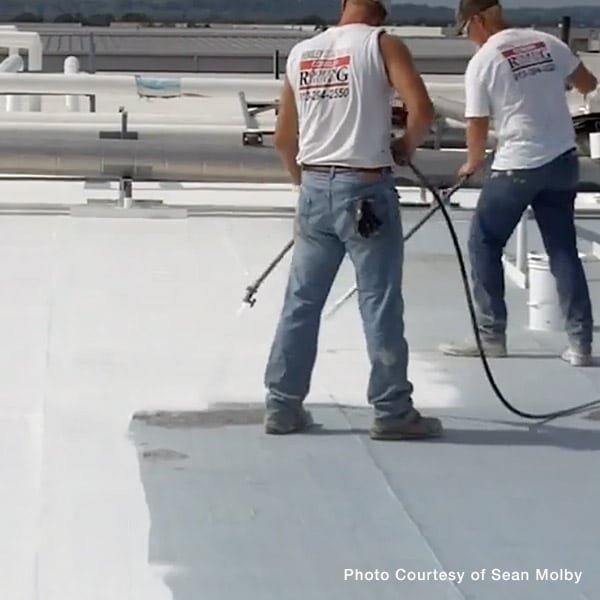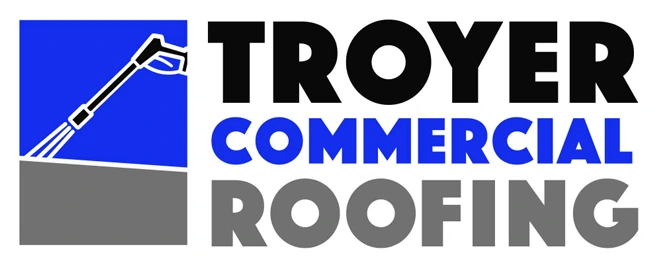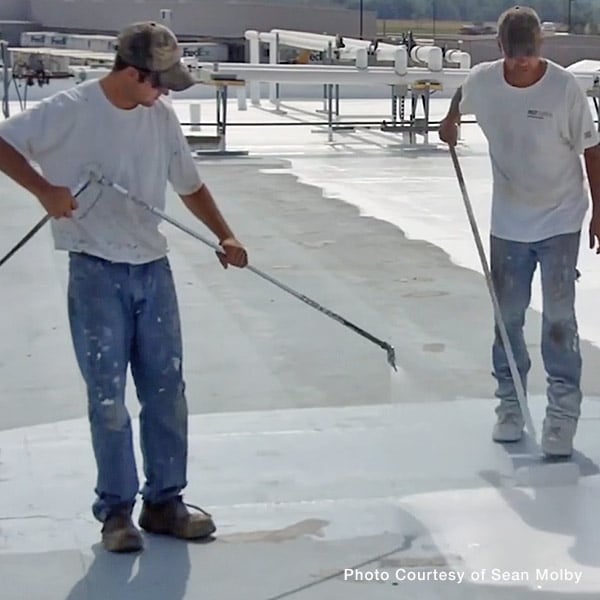Built-Up Roof Restoration Coating System
Built-Up Roofing or BUR has been a popular type of roof for more than a century. It is also one of the most common roofing systems installed on commercial buildings for low-slope or flat roofs. A BUR is a multi-ply roof composed of alternating layers of asphalt and felt ply sheets covered with a stone or gravel top layer. While built-up roofing systems are usually considered low maintenance, they are prone to weather-related damage. It is common to see effects such as cracking and blistering from heavy rains, hail, and gusty winds. These adverse weather conditions are all typical in Florida due to its proximity to the Gulf.
 Built-Up Roof Repairs
Built-Up Roof Repairs
Rainwater can leak through cracks and any open joints in the BUR that can damage the underlayment and roof deck. Since replacing a built-up roof requires the tear-off of the original rooftop, it is costly to replace. A replacement roof is also time-consuming to install. Although BURs have insulation to help protect against UV damage, asphalt roofs still absorb most solar radiation. Therefore, A BUR is not considered an energy-efficient roofing system.
Built-Up Roof Restoration Without Replacement
However, Troyer Commercial Roofing can provide commercial building owners, property managers, and facility managers, a seamless, weatherproof, and energy-efficient BUR. Our reflective restoration coating system fixes roof leaks and extends the useful lifespan of your existing low-slope built-up roof for ten years or more without the need for a costly and time-consuming roof replacement. Its moisture and fire-resistant barrier protects the roofing system. The only required maintenance is a periodic recoating every few years to maintain its strength and durability. Additional recoating not only prolongs the life of your existing BUR, but its low-weight material also doesn’t significantly increase the building’s load. This is very beneficial for aging roofs.
BUR Cool Roofing System
Another excellent reason to choose our white, reflective acrylic elastomeric coating is that it transforms your built-up roof into a cool roofing system. With a solar reflective index rating of 107, it is one of the most energy-efficient roofing materials in the industry. It reflects over 85% solar radiation reducing the roof’s surface temperature by 50°F to 60°F or more. That means your indoor temperatures will be much cooler and more comfortable. Plus, your HVAC equipment will perform more efficiently with fewer breakdowns and repairs. Also, your commercial operation will spend up to 30% less on HVAC costs. The insulated coatings will also keep your building warmer in the winter so that you will enjoy energy savings all year long. In addition, the Conklin coatings we use meet strict EnergyStar standards and building codes for cool roofs.
Roof Repairs in Florida
The roofing professionals at Troyer Commercial Roofing are factory-trained to install the Conklin Roofing System. First, we use a spray polyurethane foam (SPF) that automatically seals leaks, flashing, cracks, and splits, making installation fast and easy. Finally, we apply a topcoat covering the entire roofing surface forming a protective membrane that creates a durable, weather- and fire-resistant, and energy-efficient roofing system.
 Built-Up Roof Restoration Coating Installation
Built-Up Roof Restoration Coating Installation
Instead of repairing or replacing your built-up roof, let us show you how your commercial operation can save money and extend the life of your existing roofing system with our built-up roof restoration coating system in Sarasota FL. We are offering FREE roofing inspections for agricultural, industrial, warehouses, and other commercial buildings in Bradenton, Sarasota, Venice, Port Charlotte, and surrounding Florida communities for a limited time. Call to schedule an appointment today!
Advantages of Built-Up Roofing (BUR)
Durability and Longevity
Built-up roofs (BUR) are known for their impressive durability and long lifespan, making them ideal for commercial properties with low-slope or flat roofs. The multi-layered structure of asphalt and felt sheets provides excellent waterproofing and protection against weather elements. This system is especially beneficial in areas with high rainfall, such as Florida. The top gravel or stone layer further enhances the roof’s ability to resist damage, ensuring long-lasting performance.
Weather Resistance and Fire Protection
The built-up roof is designed to withstand extreme weather conditions, offering superior protection against rain, wind, and UV rays. Its top layer of stone or gravel acts as a shield, absorbing and deflecting the harmful effects of the sun. Additionally, built-up roofs are naturally fire-resistant due to the composition of asphalt and aggregate. This fire protection provides an extra layer of safety for commercial buildings, reducing the risk of fire damage.
Disadvantages of Built-Up Roofing
Labor-Intensive Installation
Installing a built-up roof is a labor-intensive process that requires multiple layers of materials, making the overall installation time-consuming. This increases the cost of labor compared to single-ply roofing systems like TPO or EPDM, which are faster and simpler to install. The complex installation also means more materials are used, which can contribute to higher costs for both materials and labor, making BUR a more expensive option initially.
Heat Absorption and Energy Efficiency Issues
While built-up roofs are durable, they tend to absorb a lot of heat, particularly in warm climates like Florida. Asphalt is notorious for retaining heat, which can increase the temperature inside the building, leading to higher cooling costs. Without a reflective coating, BUR is not as energy-efficient as other roofing systems, like TPO or PVC, that are designed to reflect sunlight. This makes it less ideal for buildings prioritizing energy efficiency.
Comparison Between Built-Up Roofing and Other Roofing Systems
BUR vs. Single-Ply Systems
Compared to single-ply systems such as TPO, EPDM, or PVC, built-up roofs offer more layers, which provide superior durability and better protection against water infiltration. However, single-ply systems are generally more energy-efficient and faster to install, making them more suitable for projects requiring quick turnarounds. BUR’s multi-layer design, though robust, lacks the reflective properties of single-ply membranes, which are often preferred for energy savings in hot climates.
BUR vs. Metal Roofing
Built-up roofs differ from metal roofing in several ways. While metal roofs can last for 50 years or more, they may not provide the same level of insulation or fire resistance as a BUR. Built-up roofs, on the other hand, offer excellent waterproofing and better thermal insulation, which can be particularly useful in commercial buildings. However, metal roofing systems have a longer lifespan and require less maintenance, making them a long-term investment for many property owners.
Common Signs of Damage on Built-Up Roofs
Cracking and Blistering
Over time, a built-up roof may show signs of damage, such as cracking or blistering. These issues often arise due to temperature fluctuations and the expansion and contraction of the asphalt layers. Blisters may form when air or moisture gets trapped between the layers, leading to weak spots that can worsen if not addressed promptly. Regular inspections are key to catching these issues early before they escalate into more costly repairs.
Ponding Water and Gravel Displacement
Poor drainage is a significant concern for built-up roofs, as it can lead to ponding water on the surface. Prolonged exposure to standing water can deteriorate the asphalt layers, increasing the risk of leaks. Additionally, displacement of the gravel or stone top layer can expose the underlying asphalt to UV radiation, causing it to degrade more quickly. Addressing drainage issues and ensuring the top layer remains intact can help prevent these problems.
When to Consider Restoring a Built-Up Roof
Indicators of Wear and Tear
Restoration should be considered when your built-up roof starts showing signs of aging, such as cracks, blisters, or an increase in energy bills. These are indicators that the roof’s ability to protect your building is diminishing. Rather than opting for a costly tear-off and replacement, restoring the roof with a protective coating can extend its life and improve its energy efficiency. Restoration is an effective way to revitalize your existing roofing system.
Energy Efficiency Improvements
By applying a reflective coating, a built-up roof can be transformed into a more energy-efficient system. This not only extends the roof’s lifespan but also reduces energy costs by reflecting more sunlight and lowering indoor temperatures. In regions like Florida, where cooling expenses are high, this is an effective way to reduce utility bills. Additionally, reflective coatings help protect the roof from UV damage, further enhancing its durability and performance.
Cost-Effective Ways to Extend the Life of a Built-Up Roof
Regular Maintenance
Regular maintenance is key to extending the life of a built-up roof. Routine inspections can identify minor issues like cracks or loose gravel before they become major problems. Cleaning debris, maintaining drainage systems, and addressing minor repairs promptly can help ensure the roof performs well over time. Maintenance is a low-cost, proactive approach to maximizing the lifespan of your BUR, preventing expensive repairs or the need for a full replacement.
Recoating for Enhanced Durability
Recoating your built-up roof with an elastomeric coating can enhance its durability and energy efficiency. Reflective coatings not only seal leaks but also protect the roof from UV radiation and weather damage. This process adds years to the life of the roof and reduces energy costs by keeping the building cooler. Recoating is a more affordable option than replacing the entire roof and helps maintain its integrity over the long term.
The Benefits of Applying Cool Roof Coatings to Built-Up Roofs
Reducing Heat Absorption
Applying a cool roof coating to a built-up roof significantly reduces heat absorption, which is especially beneficial in hot climates like Florida. These coatings reflect a large portion of the sun’s rays, reducing the surface temperature by as much as 50°F. This helps lower indoor temperatures, making the building more comfortable and decreasing the strain on HVAC systems, which can lead to significant energy savings over time.
EnergyStar Compliance and Savings
Cool roof coatings not only improve energy efficiency but also help your roof meet EnergyStar standards. This can qualify your building for tax incentives, rebates, and other financial benefits, further offsetting the cost of installation. The reduction in cooling costs can quickly add up, making cool roof coatings a smart investment for commercial properties looking to enhance energy savings while extending the lifespan of their existing built-up roof.
The Impact of Florida’s Weather on Built-Up Roofs
Weather Challenges in Florida
Florida’s extreme weather poses several challenges to built-up roofs. The combination of intense heat, UV radiation, heavy rains, and frequent storms can accelerate wear and tear, leading to issues like cracks, leaks, and blistering. Built-up roofs in this region need regular inspections and maintenance to stay in optimal condition. Addressing small issues early can prevent more serious damage and help the roof withstand Florida’s harsh climate.
The Importance of Regular Inspections
Regular inspections are essential for maintaining a built-up roof, especially in Florida. Inspections can help identify early signs of damage, such as displaced gravel, deteriorating flashing, or ponding water. By catching these problems early, you can prevent more extensive damage and prolong the roof’s lifespan. In Florida’s unpredictable weather conditions, inspections should be scheduled regularly to ensure the roof continues to perform effectively.
7-Step Summary Of Troyer’s Commercial Roof Restoration Process
1. Roof Inspection and Evaluation
Troyer Commercial Roofing begins their restoration process with a thorough roof inspection to assess the current condition of the roof. This evaluation helps identify problem areas such as leaks, cracks, and areas with significant wear and tear. By diagnosing these issues early on, they can formulate a customized restoration plan tailored to the specific needs of the roof. This step is crucial for determining whether restoration is viable and which repairs or reinforcements are required to ensure long-term roof performance.
2. Thorough Roof Cleaning
Before applying any restorative coating, the roof surface must be thoroughly cleaned. Troyer Commercial Roofing removes dirt, debris, old coatings, and any other contaminants that could interfere with the new restoration materials. This step ensures the roof is prepared for proper adhesion of the Conklin® coatings. A clean surface is critical for creating a seamless and strong bond that will ensure long-lasting durability. This deep cleaning process also helps expose hidden issues that need to be addressed before proceeding.
3. Repairing Leaks and Damage
Once the roof is cleaned, Troyer Commercial Roofing focuses on repairing all visible damage. This includes fixing leaks, cracks, and deteriorated seams, as well as reinforcing flashing and other vulnerable areas. These repairs are necessary to restore the roof’s structural integrity and prevent further deterioration. The team ensures that every weak point is sealed and strengthened before applying the roof coatings, ensuring the restored roof performs optimally under challenging weather conditions and extends its lifespan without recurring issues.
4. Application of Conklin® Coating
After the roof is cleaned and repaired, Troyer Commercial Roofing applies the Conklin® roof coating. This elastomeric coating is designed to create a seamless, waterproof barrier over the entire roof surface. The coating protects the roof from moisture infiltration, which is crucial in preventing leaks and water damage. Additionally, it adds durability, helping the roof withstand the wear and tear caused by weather, UV exposure, and temperature fluctuations. The seamless application ensures a uniform finish that eliminates common weak points found in traditional roofing systems.
5. Sealing and Reinforcing
In addition to the primary coating, Troyer Commercial Roofing reinforces critical areas such as seams, fasteners, and roof edges. These areas are particularly vulnerable to leaks and damage, so additional reinforcement ensures the roof remains watertight and secure. The reinforcement process also adds structural stability, ensuring the roof can endure heavy rains, strong winds, and other environmental stressors. By sealing these key areas, Troyer ensures the entire roofing system operates as a cohesive unit, maximizing the durability and performance of the restoration.
6. Energy-Efficient Finish
The final layer of the Conklin® coating provides a reflective, energy-efficient finish. This topcoat is designed to reflect a significant portion of the sun’s rays, which helps to reduce the roof’s surface temperature by up to 50°F. Lower roof temperatures mean that the building’s interior remains cooler, reducing the strain on HVAC systems and lowering energy costs. The reflective properties also help extend the life of the roof by reducing thermal expansion and contraction. This energy-efficient finish benefits the environment and results in significant cost savings for building owners.
7. Inspection and Warranty
After the roof restoration is complete, Troyer Commercial Roofing conducts a final inspection to ensure the quality of the installation and the effectiveness of the coating system. This step confirms that the restoration has addressed all problem areas and that the roof is fully protected. Additionally, the company offers long-term warranties — often up to 20 years guarantee on workmanship and coatings (depending on the coating chosen) — on their restoration systems, giving building owners peace of mind. These warranties can often be extended with re-coating, ensuring continued protection without the need for a full roof replacement in the future.

 Built-Up Roof Restoration Coating Installation
Built-Up Roof Restoration Coating Installation